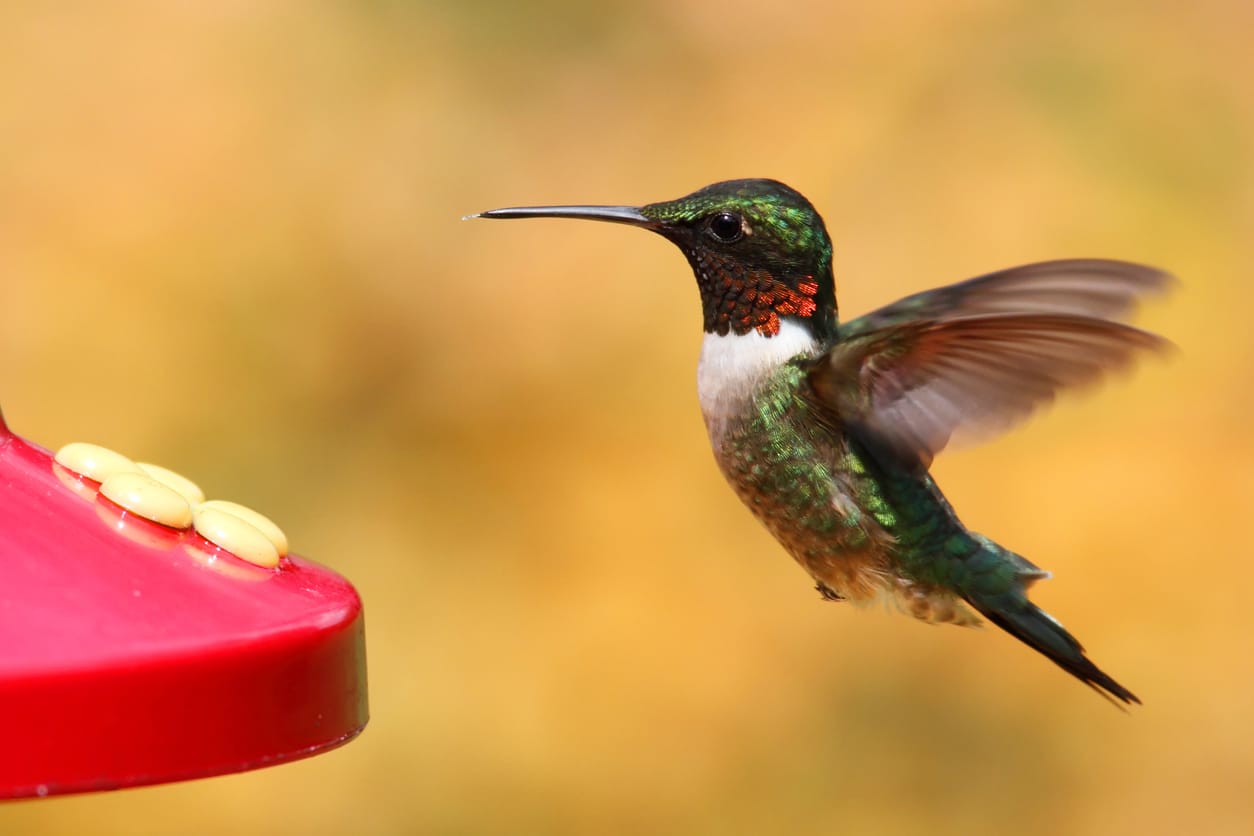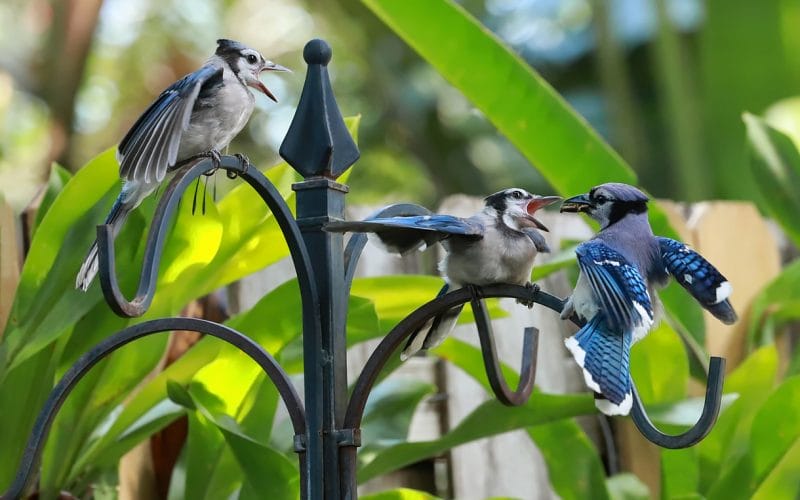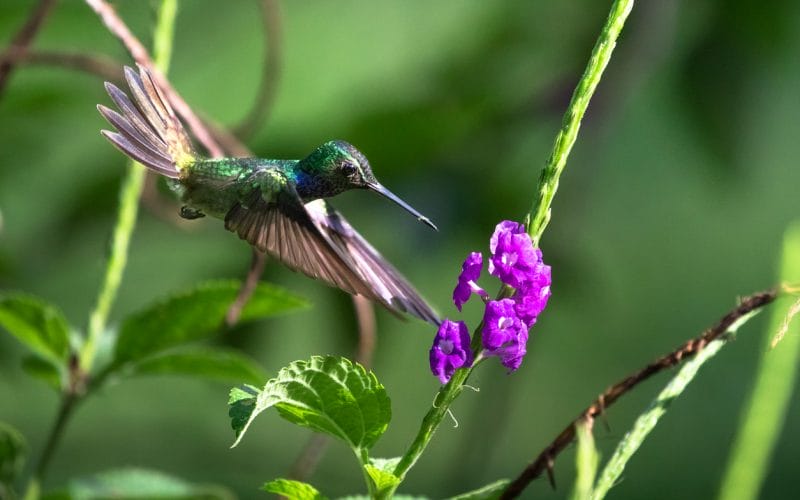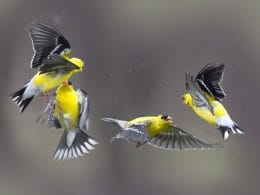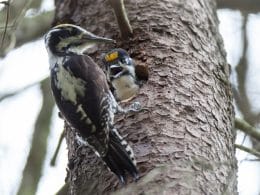Sideways, backward, forward, up, and down, hummingbirds are always on the move. For such a tiny bird, the tiniest, in fact, this species has the sparkiest attitude.
Did you know that hummingbirds are the only bird species that can be suspended in midair flight for a long time?
Hummingbirds are natural travelers. While they stay in Mexico for the winter, their breeding time is spent in the U.S, particularly Florida.
If you happen to be a birder in Florida, you’re in luck. There are numerous types of hummingbirds in the area to enjoy birdwatching.
Stick around to get a rundown of the Hummingbirds in Florida you can get your binoculars on.
11 Hummingbirds You Can Watch in Florida
Whether you’re in the park or happen to find your way on a hiking trail in Florida, there’s always a chance to catch a look at these zoomers.
Differentiating each hummingbird breed can be challenging. Nevertheless, once you take a good look at their plumage, it’ll be a dead giveaway.
Now, let’s dive into the several hummingbird breeds you can find in Florida and what makes each one special.
1. Black-chinned Hummingbird
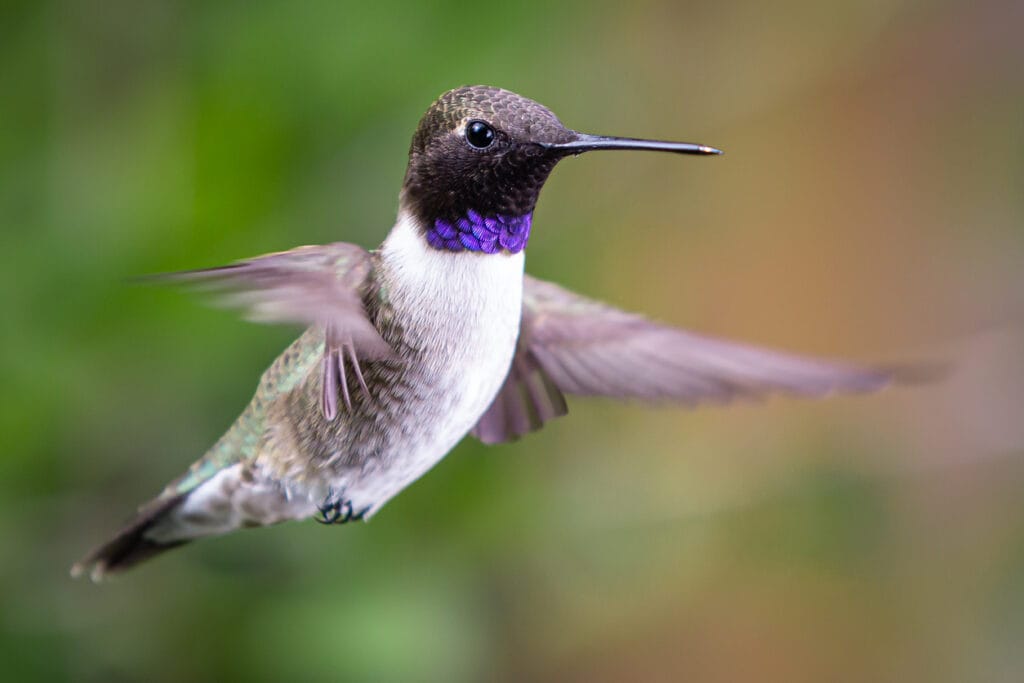
Even though most hummingbird species spend their winters in Mexico, a few Black-chinned Hummingbirds have been sighted in Florida during the cold months.
Author Note: The Floridian species are equipped with a 4.3-inch wingspan, are 3.5 inches in length, and weigh a delicate 0.1 oz.
Black-chinned hummingbirds have a distinct color pattern. Their heads are black, and males are adorned with a glowing purple neck base. The hummingbird breed has a grey chest along with some green streaks etched on its sides.
Male Black-chinned hummingbirds’ wings are completely covered in black feathers. If you take a closer look at a female, however, try to notice the faint white tips on its tail.
The breed’s beaks are thin, like most other hummingbirds. You can find them enjoying sips of nectar and munching on some tasty insects.
Black-chinned Hummingbirds are fans of tall trees; they love the view from up there. They can survey other incoming competitors and attempt to draw them out. Small as they are, they’re significantly territorial birds.
If you’re trying to listen to Black-chinned Hummingbirds, listen to their chips. If they’re on the move, you might be able to catch the sound of their zooming wings.
2. Rufous Hummingbird

Otherwise known as Selasphorus, Rufous Hummingbirds are truly fearless little birds. While they have the appearance of a hummingbird, they’re eagles at heart.
You can see these bold hummingbirds flying after bigger birds and sometimes even rats. They mostly reside in gardens, swamps, and forests where prey is plentiful – from the south all the way up to Michigan.
These hummingbirds are 2.8 inches in length, have a 4.3-inch wingspan, and clock in at a feathery 0.1 oz.
Rufous Hummingbirds eat insects, like gnats and spiders. If a tree happens to have an open tap of sap, this hummingbird won’t leave much to waste.
Since they don’t like to waste resources, Rufous Hummingbirds use spider webs and an array of twigs they forage after to craft their three or two-egged nests.
If you’re on the lookout for Rufous Hummingbirds, search for a flash of vibrant orange. Their heads and backs are covered in it. You can also look for their beautiful bright red gorgets.
As their name suggests, they have rufous-colored (reddish-brown) spots around their tails and sides. Finally, these hummingbird species have pure white chests.
For the most part, you can hear Rufous Hummingbirds’ “chu-chu-chu’s” or warbling sounds. These hummingbirds are especially faster in flight, making their wing-flapping sounds more distinguished.
3. Allen’s Hummingbird
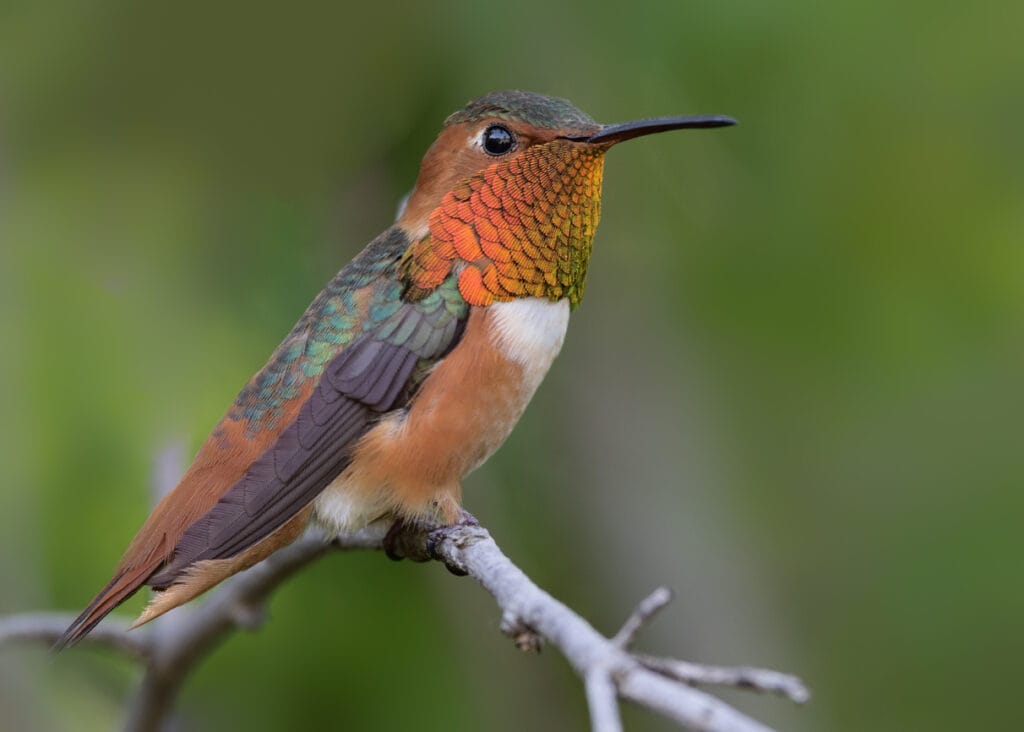
Allen’s Hummingbirds are similarly colored to Rufous Hummingbirds. Nevertheless, the chances of you spotting Allen’s Hummingbirds are, undoubtedly, low.
Top Tip: While you can find most Allen’s Hummingbirds perched on a Californian coast, they do have occasional winter visits to Tampa.
These hummingbirds are almost identical to Rufous breeds because of their iridescent orange heads and backs, as well as their sizes.
If you’re trying to tell which is which, check their backs. Allen’s Hummingbirds commonly have green patches and narrower tail feathers. In addition, they have a more coppery tint on their throats and are rounder, as well.
If you’re trying to hear Allen’s Hummingbirds around, they sound almost identical to flying bumblebees buzzing around. Whenever males are defending their space from strangers, they give off a three-note buzz.
If you want Allen’s Hummingbirds to pop a visit to your backyard, try to lure them in with some sweet nectar. You can plant paintbrush flowers, red salvia, and honeysuckle. Make sure to keep a hummingbird feeder for their needle-like bills.
In the wild, Allen’s Hummingbirds prefer bushy areas where they can find larger amounts of grub and food to satiate their undying metabolism.
4. Broad-tailed Hummingbird

Like Allen’s Hummingbirds, Broad-tailed Hummingbirds also belong in the rare-to-spot category. If you want to catch a peek at these mysterious hummingbirds, we recommend going to the northwestern region in Florida.
While they’re sparsely scattered around that area, they are truly a sight to behold. Broad-tailed Hummingbirds almost look like something out of a Disney movie.
Their color pattern is unique. Broad-tailed Hummingbirds have gorgeous magenta necks, specifically the males. Their heads and backs are engulfed in shimmery green, while their bellies are white. Once in flight, you can easily point out their white-tipped tails.
You’re likely to find Broad-tailed Hummingbirds on a mountain hike. They’re usually found in higher elevations. This breed protects its nests from the cold by placing them behind branch-sheltered spaces.
What’s most interesting about this hummingbird species is how they survive in icy temperatures in high altitudes. The minuscule birds somehow decrease their heart rate and metabolism by reducing their physical movement levels. This is referred to as a state of torpor.
That way, they consume less energy and are more likely to survive their challenging environment and habitat.
Broad-tailed Hummingbirds sound like insects, particularly crickets. They chitter over competitors trying to drink from their nectar.
5. Ruby-throated Hummingbird

When it comes to hummingbirds in Florida, the Ruby-throated Hummingbird is the star of the show. They mostly migrate within North America.
Ruby-throated Hummingbirds can even be characterized as Florida backyard birds because they often visit tube feeders filled with sugar water.
If you want these hummingbirds to come more often, try planting honeysuckle, bergamot, and red cardinal flowers. Not only will you attract Ruby-throated Hummingbirds, but your garden will look picturesque.
Top Tip: Apart from your backyard, Ruby-throated Hummingbirds can be found hovering over orange and red flowers. You can check out their habitat in the woods and meadows.
This hummingbird breed has a relatively similar color pattern to the Broad-tailed Hummingbird. Their heads and backs are an iridescent green, but Ruby-throated Hummingbirds have mesmerizing ruby red necks. There are also golden specks around their backs here and there.
Listening to Ruby-throated Hummingbirds won’t be a challenge since they emit a distinct “chee-dit” noise whenever they communicate with each other. Like most other hummingbirds, you can also try to listen to the whirring sound of their erratically flapping wings.
6. Anna’s Hummingbird

This exquisite hummingbird species is named after the royal Italian Dutchess, Anna Massena. This breed is unlike any other hummingbird species for numerous reasons.
For one, female Anna’s Hummingbirds are blessed with bright ruby necks, unlike the vast majority of dull-colored hummingbirds.
Anna’s Hummingbirds have particularly weak bills. So much so that some bees and wasps are capable of impaling the hummingbird’s beak. This eventually causes the bird to die from starvation.
Speaking of starvation, Anna’s Hummingbirds drink from desert willow, eucalyptus, and hummingbird sage.
This hummingbird breed is alluringly covered in pink plumage around its neck and face. Meanwhile, the rest of its body is green. You can also find brown and gray streaks strewn around its flanks and wings.
Anna’s Hummingbirds have a pleasant singing voice. Their songs are relatively longer than most other hummingbird species, lasting over ten seconds. These hummingbirds don’t necessarily repeat a certain tune, but rather, have a series of tones embedded in their songs.
They start with a buzzing noise, move on to a whistling sound, and finally a gentle chipping melody.
7. Buff-bellied Hummingbird
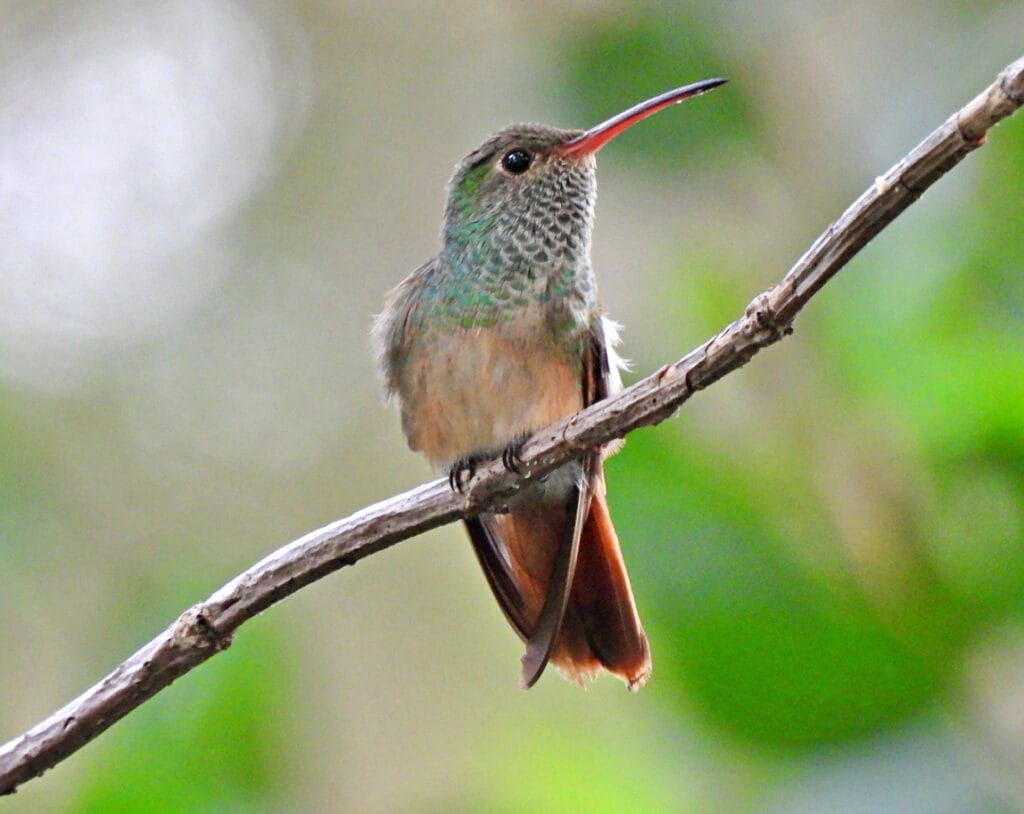
From this hummingbird breed’s name, we’re sure you can guess that they have buff-colored bellies. We wouldn’t say that’s their main attraction, though.
Buff-bellied Hummingbirds have uniquely colored bills. They have elongated red beaks signed with black tips. The breed is also decorated with glowy green necks.
You can spot Buff-bellied Hummingbirds from their rufous-colored tails and brownish wings.
Buff-bellied Hummingbirds will chase away smaller hummingbird intruders, unlike the bold and brave Rufous Hummingbird.
They are fond of small insects and hummingbird feeders. You can find them hovering around in parks and woodland areas.
Buff-bellied Hummingbirds have a few recognizable sounds. They can either make a continuous, “see-see-see-su-su,” some “tik-tiks,” or “tsi-we.” Each sound varies on occasion depending on whether they’re warding off competitors or displaying for courtship.
8. Broad-billed Hummingbird
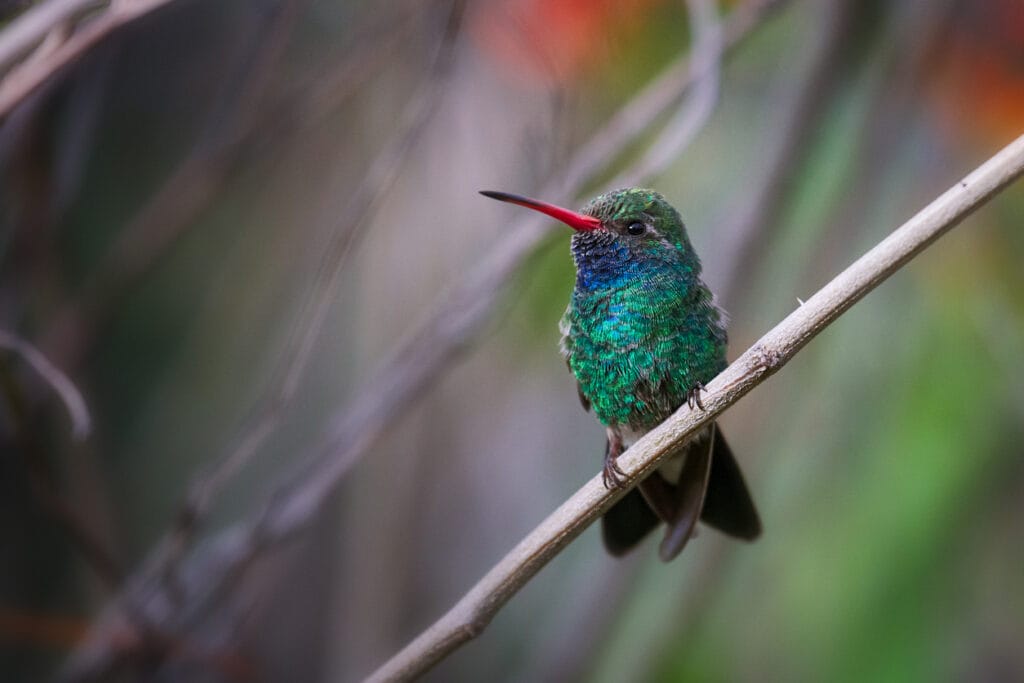
Broad-billed Hummingbirds look like small flying mermaids. Their bodies are all mostly green, while their throats are a deep, cerulean blue. Like Buff-bellied Hummingbirds, the Broad-billed variety also has black-tipped red bills.
For higher chances of backyard visits, we recommend planting some honeysuckle, paintbrush, and Ocotillo.
When males are displaying for a mate, they perform an interesting flight performance where they move around the potential mate like a pendulum.
Like Broad-tailed Hummingbirds, Broad-billed Hummingbirds are also fond of higher elevations. Their ideal environment consists of mountainous regions.
Trying to hear their call? Listen closely to their chipping notes and “je-dit” sounds.
9. Calliope Hummingbird
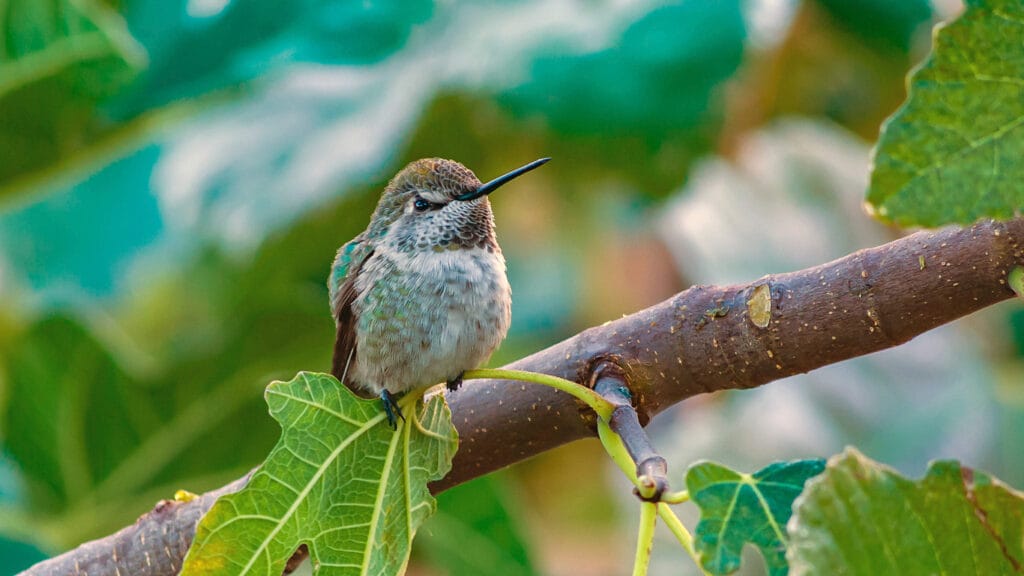
Hummingbirds are already miniature, yet Calliope Hummingbirds are somehow more minuscule than most hummingbirds on this list.
Author Note: They’re 3.1 inches in length and can weigh a feathery 0.071 oz. This bird would easily hide away from its prey.
Calliope Hummingbirds’ main attraction is their Fuschia-colored necks. Their wing shell is green with some splotches of grey and brown around. They also have a white chest.
The hummingbird breed’s beaks are also considerably short when compared to other hummingbirds.
To bulk up on their fat and protein intake, Calliope Hummingbirds gorge on insects they find strewn around in plants. Nevertheless, you can’t undermine their sweet tooth. They also enjoy drinking flower nectar.
Their calls are similar to most other hummingbirds. Calliope Hummingbirds emit chipping and buzzing sounds when they’re communicating with other hummingbirds or calling for a mate, respectively.
10. Costa’s Hummingbird

A rare sighting but a must-see indeed, Costa Hummingbirds are one of the most uniquely colored bird species around.
Since purple is a symbol of royalty and wealth, it’s no surprise that Costa Hummingbirds were named after a French nobleman.
Costa’s Hummingbirds’ heads are framed with an exotic purple color. They have white chests and the rest of their bodies are mostly green with brown specks muddled around.
This hummingbird species carries a high-pitched four-note sound that lasts about a second or so.
11. White-eared Hummingbird
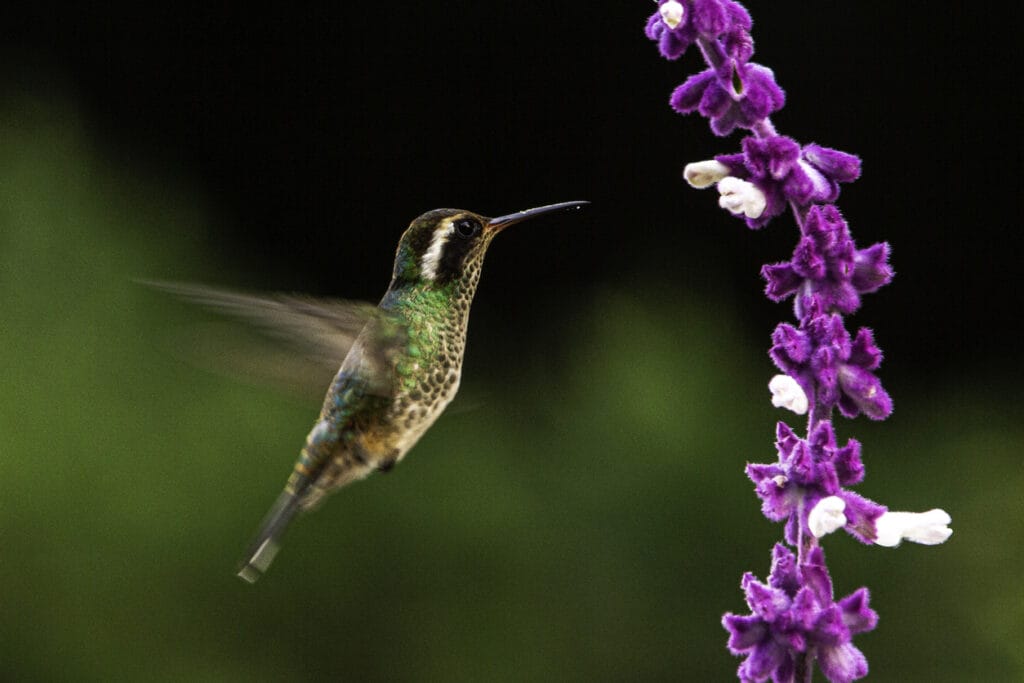
White-eared Hummingbirds mainly have one distinct feature; the white stripe behind their eyes. Once you notice those markings, you’ll easily find out that you’re looking at a White-eared hummingbird.
These hummingbirds rarely nest around North America. White-eared Hummingbird females build their nests out of moss, cups of grass, and pine needles. They use the grass as a natural element of disguise from potential predators.
Author Note: Once females catch insects, they throw them back up to provide for their young.
To Conclude
Hummingbirds in Florida are easy to spot. Most hummingbirds coming to Florida are embellished in rich colors that are hard to miss.
If you’re a birding enthusiast, we recommend jotting down your sightings for other hummingbird fans to see. You can include them in common birding forums or simply tell your birding friends.
Next time you listen to a buzzing sound, don’t always assume it’s a bee out to get you. Who knows? You might’ve stumbled upon a new hummingbird species in the area.
FAQ
The acknowledged season for hummingbirds in Florida is March to September. However, you may well see them year round as some may spend winter here.
Plant flowers that they want to feed from. They should be brightly colored with tubular flowers like hibiscus or the native coral honeysuckle.
As it is across the U.S., the Ruby-throated Hummingbird is the most common species in Florida.




